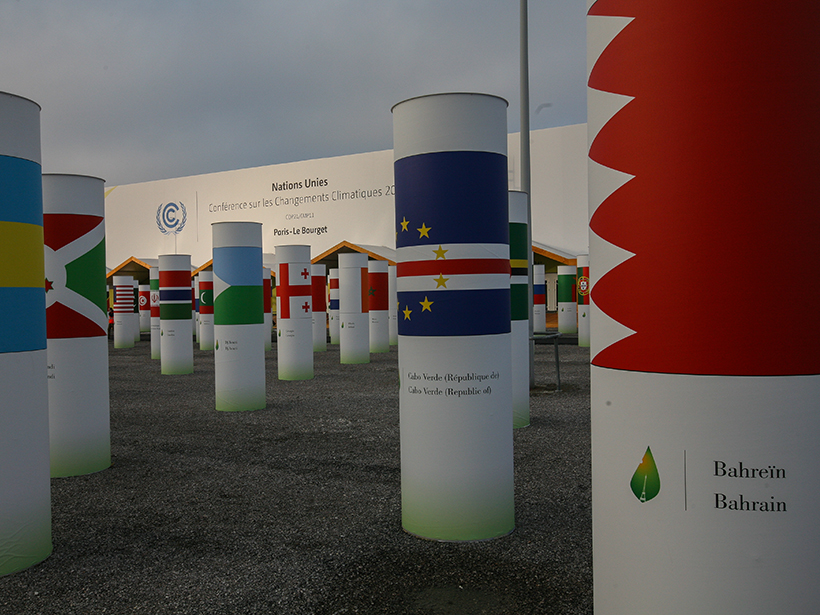From 29 November to 11 December 2015, the 197 parties to the United Nations Framework Convention on Climate Change (UNFCCC) held the 21st Conference of Parties (COP21) in Paris. During the 10 months preceding this conference, countries submitted their Intended Nationally Determined Contributions (INDCs).
Among other things, these short public documents summarized, for each country, the domestic objectives for reducing emissions of greenhouse gases by 2025–2030. The INDCs vary considerably in terms of format and information content.
A diverse group of scientists from Europe and the United States, representing scientific institutes, government labs, and independent organizations, met for a scientific workshop at the Institut Pierre Simon Laplace in Paris on 3 November 2015. They discussed the implications of the INDCs for global 2030 emissions of greenhouse gases and future emission trajectories. The 2009 Copenhagen Accord, which endorsed that the world should seek to limit warming to 2°C, provided context.
Even fully implemented, Intended Nationally Determined Contributions remain insufficient to bring global greenhouse gas emissions onto a path to limit global warming below 2°C.
The INDCs provided estimates that 52 to 64 billion metric tons of carbon dioxide equivalent will be emitted globally in 2030. Several analyses indicate that INDCs, taken collectively, make a significant difference relative to “business as usual” or “current policies” scenarios. However, even fully implemented, workshop participants found that INDCs remain insufficient to bring global greenhouse gas emissions onto a path to limit global warming below 2°C.
Differences in projections of warming by the end of the century appear to be related to assumptions made on emission trajectories and the ambitiousness of climate policies beyond 2030 rather than differences in methodology or climate modeling. Various groups calculated temperature change projections differently, basing them, for example, on 50% or 66% likelihood and a 2100 or longer time horizon.
The causes of these varying estimates could not be unraveled in detail during the workshop. They appear to be related to differences in interpretation of INDCs, assumptions about other countries, level of disaggregation for small countries, choice of global warming potentials to compute carbon dioxide equivalent emissions, treatment of emissions related to land use, and treatment of international aviation and maritime shipping.
The workshop participants agreed that the lack of a standard format for the INDCs complicates their interpretation.
The workshop participants agreed that the lack of a standard format for the INDCs complicates their interpretation. The UNFCCC negotiation process requires flexibility in the presentation of INDCs, but the workshop participants felt that our understanding of future emission trajectories would benefit from additional information communicated by the UNFCCC participants in upcoming negotiation cycles.
In particular, the complexity of carbon sink and source accounting requires separating the contributions from land use, land use change, and forestry from those of other areas. Emissions from industry, transportation, and other sectors may have to be treated separately. Translating contributions into absolute emission levels requires further information, as does assessing the transformative power of the INDCs and their long-term implications for emission trajectories.
Workshop participants agreed on the value of having a diversity of methodologies in assessing INDCs and the importance of clarity and transparency when presenting their assessments.
The workshop organizers thank the participants for fruitful discussion and François-Marie Bréon for chairing one of the discussion sessions.
—Olivier Boucher and Hélène Benveniste, Institut Pierre Simon Laplace, Paris, France; email: [email protected]; and Céline Guivarch, Centre International de Recherche sur l’Environnement et le Développement, Nogent-sur-Marne, France
Citation: Boucher, O., H. Benveniste, and C. Guivarch (2016), Nations’ pledges to reduce emissions and the 2°C objective, Eos, 97, doi:10.1029/2016EO052397. Published on 17 May 2016.
Text © 2016. The authors. CC BY-NC-ND 3.0
Except where otherwise noted, images are subject to copyright. Any reuse without express permission from the copyright owner is prohibited.

